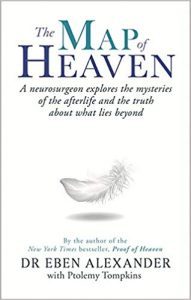Book review by David Lorimer
THE MAP OF HEAVEN
Eben Alexander with Ptolemy Tompkins
Piatkus, 2014, 165 pp.
ISBN: 978-0-349-40351-9
It was a real pleasure to meet and share a platform with Eben Alexander at a conference on Infinite Consciousness in Italy last week. Many readers will recall that Eben is a neurosurgeon who had a profound near death experience recounted in his bestselling book Proof of Heaven, also reviewed in these pages along with the book by Anita Moorjani. This experience completely transformed his worldview and in particular his views on consciousness. He told the conference that when he met his current partner Karen Newell – see below – and she asked him about the most transformative aspect of his experience, he said ‘the brain does not produce consciousness’. This was not a surprise to her, but it is a fundamental shift for a neuroscientist, which most are unwilling to take, as Eben has discovered with the vehement reactions to his books.
This book takes the story to the next phase, incorporating as it does a great many profound letters that he has received from readers. These all point to a larger and deeper reality within which we are embedded, and of which the physical world is an aspect rather than the whole. The book is structured around seven gifts derived from his experience: knowledge, meaning, vision, strength, belonging, joy and hope. He begins by affirming the deep reality of love beyond its electrochemical manifestation in the brain. This echoes the central message of his earlier book and of many other experiences. At some point in our lives, we all ask the fundamental questions of who we are, where we came from and where we are going (p. xvii), but usually we revert to getting on with life, as my father recommended to me when I was writing my first book. Following in the footsteps of the quantum physicists of the 1930s, more people are arriving at the conclusion that consciousness is in some way fundamental rather than derivative, and must be included in any adequate theory of everything. In addition, many other phenomena currently ignored by mainstream science need to be taken into account, as this Network has been arguing for over 40 years. Eben quotes Nikola Tesla as saying that ‘the day science begins to study nonphysical phenomena, it will make more progress in one decade than in all the previous centuries of its existence.’
As Michael Grosso observed in his book written during the 1980s, The Final Choice, NDEs represent the form of initiation corresponding more closely to the top-down philosophy of Plato rather than the bottom up of Aristotle. Initiation is a form of rebirth where we become aware of our true spiritual identity through direct experience. This immediately enlarges our sense of identity and reveals a deeper geography of human existence – this was indeed the result of Eben’s own experience. This is the knowledge of the first chapter, leading to a discussion of meaning in the second – an aspect of life denied by mainstream science with its repudiation of final causes and purpose. Eben advocates a reconciliation of the Platonic and Aristotelian methods to create a real shift in worldview based on rigorous assessment of a much wider evidence base than currently admitted. This would entail a corresponding move beyond what Blake called a single vision taking into account the transcendent perceptions reported in near death and mystical experiences that are utterly inexplicable – other than as a pathology – within the framework of materialist science. And it is important to note that these multidimensional experiences are transformative: people lead their lives on a new basis of oneness, love and wisdom. They draw conclusions similar to Eben, who writes (p. 95) that the earthly realm is where we learn lessons of unconditional love, compassion, forgiveness and acceptance.
It was good to see the experiences of Swedenborg properly appreciated both in a perceptual and a spiritual sense. A key idea is that, in the next world, we gravitate to where we belong corresponding to the amount of love we embody and have expressed in the physical world. Parallel ideas are quoted from the work of Pascal, Fechner and Goethe as well as William James and Sir Alister Hardy, whose book The Spiritual Nature of Man came out 30 years ago (I recently discovered that Rupert Sheldrake had had my copy for nearly as long – he found he had two!). Eben also refers to the important work going on the Division of Perceptual Studies at the University of Virginia, who have produced the volumes Irreducible Mind and Beyond Physicalism – some of the most robust studies around today.
I think Eben is right in deciding the importance of growth and evolution towards a wider and deeper sense of identity over time. As he puts it, ‘the higher in the worlds you go, the deeper the part of yourself that is being called out.’ From this vantage point, the physical world may seem like an illusion, but, as Aldous Huxley maintains, it is one that we must take very seriously. My experience of Karen Newell’s Sacred Acoustics at last week’s conference gave me a better understanding of the appendix in which this work is described. Eben discovered that he could revisit the realms of his own experience through meditation, so meditation practice becomes an important gateway and these sounds are capable of enabling a deeper state past the chatter of the brain. This bold book is an important milestone in the transformation of science towards a deeper understanding of life and consciousness.
Buy The Map of Heaven here.